小学英语名词 讲解及练习
- 格式:doc
- 大小:32.50 KB
- 文档页数:5
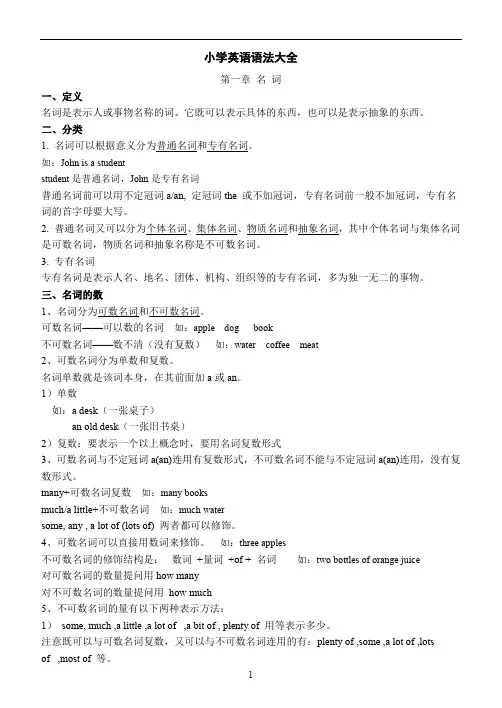
小学英语语法大全第一章名词一、定义名词是表示人或事物名称的词。
它既可以表示具体的东西,也可以是表示抽象的东西。
二、分类1. 名词可以根据意义分为普通名词和专有名词。
如:John is a studentstudent是普通名词,John是专有名词普通名词前可以用不定冠词a/an, 定冠词the 或不加冠词,专有名词前一般不加冠词,专有名词的首字母要大写。
2. 普通名词又可以分为个体名词、集体名词、物质名词和抽象名词,其中个体名词与集体名词是可数名词,物质名词和抽象名称是不可数名词。
3. 专有名词专有名词是表示人名、地名、团体、机构、组织等的专有名词,多为独一无二的事物。
三、名词的数1、名词分为可数名词和不可数名词。
可数名词——可以数的名词如:apple dog book不可数名词——数不清(没有复数)如:water coffee meat2、可数名词分为单数和复数。
名词单数就是该词本身,在其前面加a或an。
1)单数如:a desk(一张桌子)an old desk(一张旧书桌)2)复数:要表示一个以上概念时,要用名词复数形式3、可数名词与不定冠词a(an)连用有复数形式,不可数名词不能与不定冠词a(an)连用,没有复数形式。
many+可数名词复数如:many booksmuch/a little+不可数名词如:much watersome, any , a lot of (lots of) 两者都可以修饰。
4、可数名词可以直接用数词来修饰。
如:three apples不可数名词的修饰结构是:数词+量词+of + 名词如:two bottles of orange juice对可数名词的数量提问用how many对不可数名词的数量提问用how much5、不可数名词的量有以下两种表示方法:1)some, much ,a little ,a lot of ,a bit of , plenty of 用等表示多少。
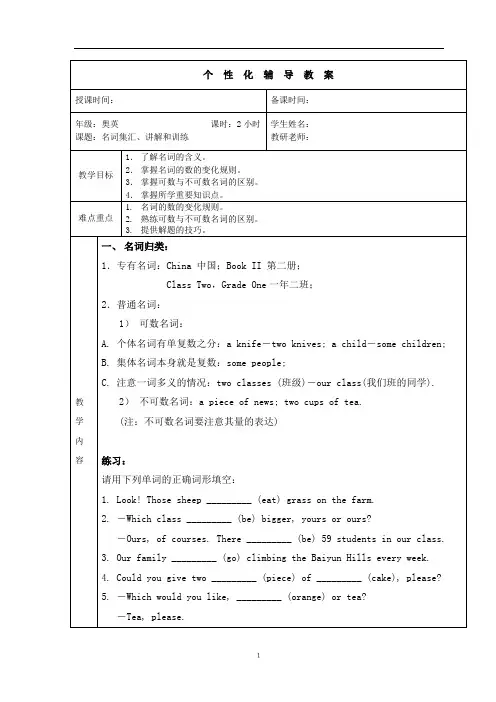
Step I. 口语:I. Answer the questions according to the pictures:1. It’s 4cm tall.2. It’s 12cm wide.3. It’s 3cm long.4. It’s 5kilos.5. I’m … metres tall.No 6 ~12 略II. Talk something about one of your best friends:仅供参考:Lily is one of my best friends. She’s 1.5 metres tall. She’s 40 kilos. She has a beautiful face and two big eyes. She likes singing and dancing and she’s good at them. Her favourite subject is English and she can speak English well. I like her very much.Step II. 基础知识:I. 翻译重点词组:11.welcome back to12.be different from13.two centimeters taller than14.how tall/ heavy/ big15.look the same / different16.Sorry, please say it again. / Pardon.17.one of the friendliest people18.be good at / be bad at19.older than the other teachers (注意:the other + n. 复数)20.better than any other teacher (注意:any other + n. 单数)II. 近义词辨析:another, other, the other, others, the others6)another7)other8)the other9)other10)the othersIII. 词形变换:6.measures metres7.paintings theirs8.worse better9.more important other10.the hottestIV. 句型转换:1. heavier than2. two years older3. Yours … mine4. How far does … jump5. How much … weighV. 选择题:1~5 DBBCDVI. 写作:1. one of my favourite animals2. live in … like eating3. are long … run fast4. the tallest animalTest for Book IIU1I. 听写:(2x10=20)1.friendliest students2.worse better3.more important4.everything nothing5.different before.II. 听力短文理解:(4x5=20)BCABBIII. 选择题:(4x10=40)1~5 ADBCA 6~10 BCCCBIII. 句型转换:(4x5=20)1. more interesting than hers2. How heavy are you?3. different from4. older than any other听力朗读部分:I. 听写:6.Lily is one of the friendliest students in the class.7.He’s worse at learning but better at playing sports than the others.8.English is more important than the other subjects.9.To do everything well is to do nothing well.10.Lingshi is very different from before.II. 听力短文理解:Mr and Mrs Brown are new to the city of London. One morning they get up very early. After they have breakfast, they leave their house at seven thirty. They get to the shop at seven fifty. In the shop they see a lot of clothing. Mrs Brown likes them. So she buys a pair of shorts for their son, a pair of shorts for their daughter, and a scarf for Mr Brown. She buys a pair of socks for herself, too.The shopping basket is full now. Mr Brown looks at his watch. Then he says, “Oh, it’s twelve o’clock. I think we must go home now. It’s too late.” So they go out of the shop and begin to go home, but they lose their way.Mr Brown drives along the street. He can’t find the way. Then he drives his car over to an old man and asks, “Excuse me, sir. Where am I?”The old man looks at him and their car, “You’re in your car, sir.” He says.。
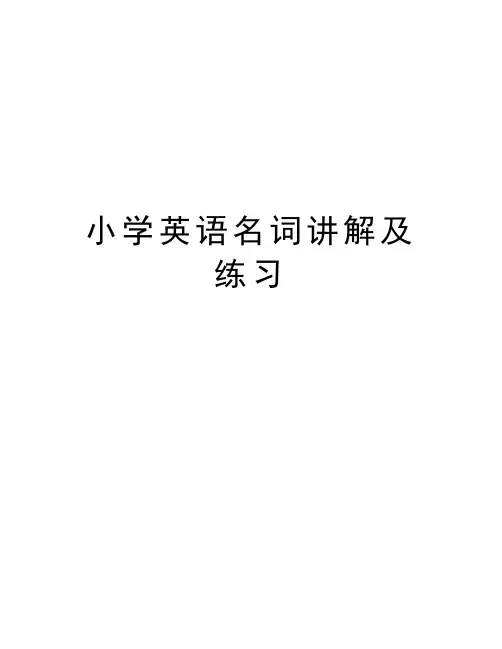
小学英语名词讲解及练习小学英语名词讲解及练习一、名词:名词是所有事物的名称,包括人、物及抽象概念。
名词分为普通名词和专有名词两大类。
名词在句子中作主语,宾语或表语等。
1.普通名词普通名词是某类人、事件、物体和抽象概念的名称。
根据所指代物体的特征,普通名词又可分为以下四类:A.个体名词: 表示人或物体中可以数清的单个体。
如:student(学生)、pen (钢笔)、bird(鸟)等。
B.集体名词: (即集合名词)表示由个体组成的集合体。
如:people(人民)、police(警察)、family(家庭)等C.物质名词: 表示构成物体物质的不可数名词,或表示无法分为个体的物质的名词。
如:water(水)、air(空气)、wood(木头)等。
D.抽象名词 : 表示动作、状态、品质、情感等非具体化的抽象概念。
如:work (工作)、peace(和平)、love(爱)等。
2. 专有名词 : 专有名词是某些人、事物、机构、组织等特有的名称。
主要包括:人名、地名、国名、党派名称等。
如:Churchill(丘吉尔)、Tokyo(东京)、China(中国)等。
找出下列笑话中的可数名词In the market, a buyer asked a seller “How much is this cat, please?” “100 dollars.” “But you only asked for 20 dollars yesterday!” “Yes, that’s true. But this cat ate a bird last night and the bird was worth 80 dollars!”二、可数名词和不可数名词。
1) 可数名词: 一般来说个体名词和集体名词可以用数目来计算,称为可数名词。
可数名词有单数和复数两种形式。
例如: a book, two books, a student, three students, a family, many families。
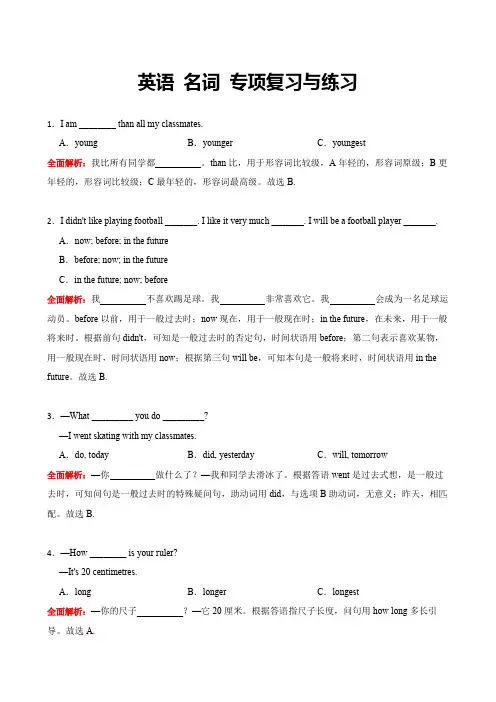
英语名词专项复习与练习1.I am ________ than all my classmates.A.young B.younger C.youngest全面解析:我比所有同学都。
than比,用于形容词比较级,A年轻的,形容词原级;B更年轻的,形容词比较级;C最年轻的,形容词最高级。
故选B.2.I didn't like playing football _______. I like it very much _______. I will be a football player _______.A.now; before; in the futureB.before; now; in the futureC.in the future; now; before全面解析:我不喜欢踢足球。
我非常喜欢它。
我会成为一名足球运动员。
before以前,用于一般过去时;now现在,用于一般现在时;in the future,在未来,用于一般将来时。
根据前句didn't,可知是一般过去时的否定句,时间状语用before;第二句表示喜欢某物,用一般现在时,时间状语用now;根据第三句will be,可知本句是一般将来时,时间状语用in the future。
故选B.3.—What _________ you do _________?—I went skating with my classmates.A.do, today B.did, yesterday C.will, tomorrow全面解析:—你做什么了?—我和同学去滑冰了。
根据答语went是过去式想,是一般过去时,可知问句是一般过去时的特殊疑问句,助动词用did,与选项B助动词,无意义;昨天,相匹配。
故选B.4.—How ________ is your ruler?—It's 20 centimetres.A.long B.longer C.longest全面解析:—你的尺子?—它20厘米。
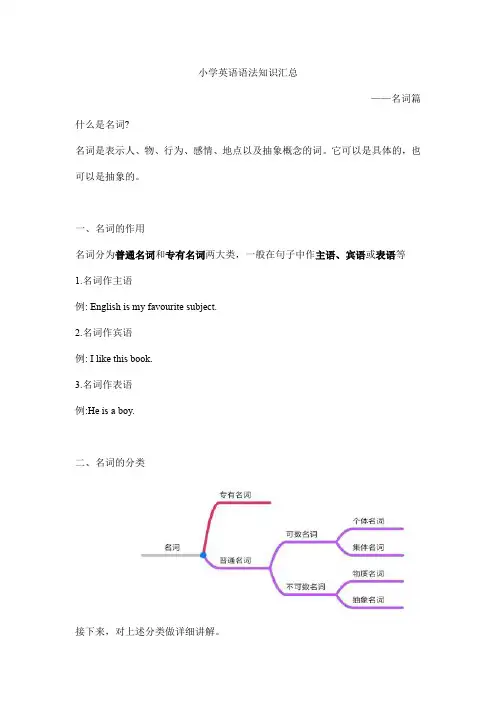
小学英语语法知识汇总——名词篇什么是名词?名词是表示人、物、行为、感情、地点以及抽象概念的词。
它可以是具体的,也可以是抽象的。
一、名词的作用名词分为普通名词和专有名词两大类,一般在句子中作主语、宾语或表语等1.名词作主语例: English is my favourite subject.2.名词作宾语例: I like this book.3.名词作表语例:He is a boy.二、名词的分类接下来,对上述分类做详细讲解。
三、专有名词表示某一特定的人、日期、事物、地点或机构等专有名称的词叫专有名词。
1.人名例: John 约翰Alice 爱丽丝Harry Potter 哈利-波特2.月份例: January一月February二月April 四月3星期例:Monday 星期一Tuesday 星期二Wednesday 星期三4.节日例: Christmas 圣诞节Easter 复活节Mother's Day 母亲节5.学科,语言例: Chinese 中文English 英语Maths 数学6.品牌例: Teddy Bear 泰迪熊7.国家,城市例: China 中国Beijing 北京Japan 日本四、普通名词普通名词是指一类人、事物、物质或抽象概念的名称。
它又可以细分为个体名词、集体名词、物质名词和抽象名词四类。
1.个体名词:表示单个的人和事物例: rubber 橡皮photo 照片student 学生2.集体名词:表示一群人或一些事物的名词例: group 集团family 家庭class 班级3.物质名词:表示无法分为个体的物质。
例:fire 火water 水air 空气4.抽象名词:表示动作、状态、品质、情况等抽象概念。
例: health 健康life 生活patience 耐心名词还可分为可数名词与不可数名词。
五、可数名词。
可数名词指能以数目来计算,可分成个体的人或东西。
可数名词有“单数”与“复数”之分。
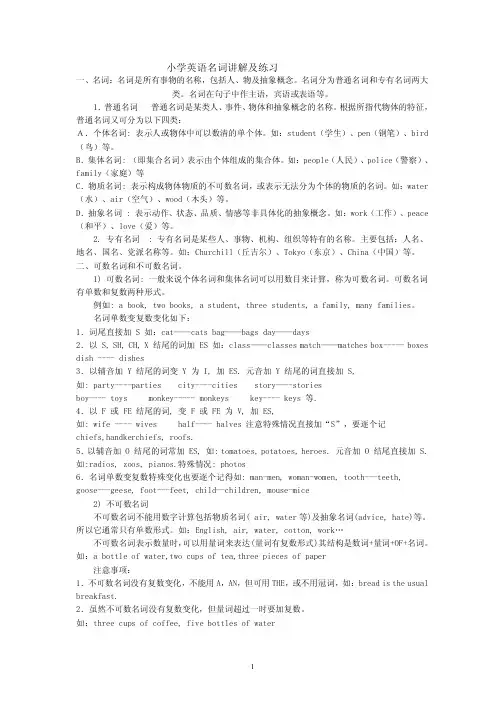

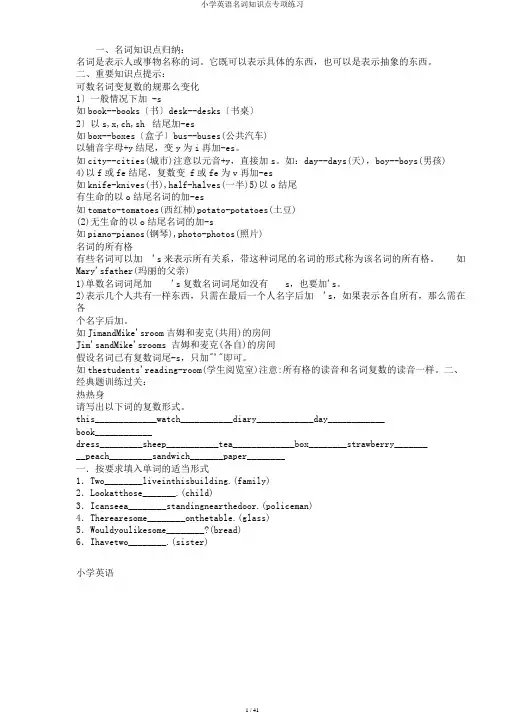
一、名词知识点归纳:名词是表示人或事物名称的词。
它既可以表示具体的东西,也可以是表示抽象的东西。
二、重要知识点提示:可数名词变复数的规那么变化1〕一般情况下加 -s如book--books〔书〕desk--desks〔书桌〕2〕以s,x,ch,sh 结尾加-es如box--boxes〔盒子〕bus--buses(公共汽车)以辅音字母+y结尾,变y为i再加-es。
如city--cities(城市)注意以元音+y,直接加s。
如:day--days(天),boy--boys(男孩) 4)以f或fe结尾,复数变 f或fe为v再加-es如knife-knives(书),half-halves(一半)5)以o结尾有生命的以o结尾名词的加-es如tomato-tomatoes(西红杮)potato-potatoes(土豆)(2)无生命的以o结尾名词的加-s如piano-pianos(钢琴),photo-photos(照片)名词的所有格有些名词可以加's来表示所有关系,带这种词尾的名词的形式称为该名词的所有格。
如Mary'sfather(玛丽的父亲)1)单数名词词尾加's复数名词词尾如没有s,也要加's。
2)表示几个人共有一样东西,只需在最后一个人名字后加's,如果表示各自所有,那么需在各个名字后加。
如JimandMike'sroom吉姆和麦克(共用)的房间Jim'sandMike'srooms 吉姆和麦克(各自)的房间假设名词已有复数词尾-s,只加"'"即可。
如thestudents'reading-room(学生阅览室)注意:所有格的读音和名词复数的读音一样。
二、经典题训练过关:热热身请写出以下词的复数形式。
this_____________watch___________diary____________day____________book____________dress_________sheep___________tea_____________box________strawberry_________peach_________sandwich_______paper________一.按要求填入单词的适当形式1.Two________liveinthisbuilding.(family)2.Lookatthose_______.(child)3.Icanseea________standingnearthedoor.(policeman)4.Therearesome________onthetable.(glass)5.Wouldyoulikesome________?(bread)6.Ihavetwo________.(sister)小学英语7.Ilike________.(cat)8.Doyouwantsome________forsupper?(potato)9.Hehastwo________.Oneisold,theotherisnew.(watch) 10.Inautumn,youcanseealotof________ontheground.(leaf) Ihavetwo____________(knife)Therearemany___________here.(box)Therearemany___________ontheroad.(bus)______________areplayingfootballnow.(child)taketwo_______________forme.(photo)二.选用以下正确的单词或词组,在正确的选项上打√1.Doyoudrinkmuch(milk,milks)?2.Ivisited(Tom,Tom's)houseyesterday.3.Hehadtwo(cup,cups)oftea.4.Thisis(TomandMary's,Tom'sandMary's)house.5.Givemea(pieceof, )paper,×please.6.Idon'twant(a,an)oldcap.7.Lookatthose(sheep,sheeps).8.Howmany(radioes,radios)canyousee?9.Thereare36(boys,boies)inmyclass.10.Thatbagismy(father's,father'sbag.)三.将以下句子变成复数形式1.Thisisaknife._________________________________________ 2.Thatisatomato._________________________________________ 3.Ihaveawish._________________________________________ 4.Thatchildisverylovely.___________________________________ 5.AnEnglishmanstoodthere.__________________________________四.用's,s'替换以下词组1.thelegoftheboy____________ __6.thesongsofthebirds____________2.thekeyofthegirl___________ ___7.theservantsofthequeen_________3.thetailofthecat___________ ____8.theshirtsofthemen_____________4.thefriendofmyfather's_____ ______9.theviolinofthegirl______________5.thetoysoftheboy___________ ____10.thepenofJohn_________________五.选择yougiveme________,please? paperspieceofpaperpiecesofpaperpiecesofpapersarethree_____andseven____inthepicture.A.monkeys,sheepsB.monkeys,sheepC.monkies,sheepD.monkies,sheepslotof____aretalkingw ithtwo_______.A.Germans,FrenchmansB.Germen,FrenchmansC.German,FrenchmenD.Germans,Frenchmenwentouttoseewhathadhappened.A.Thousandsofthousandofofthousands 小学英语5.The__inouryardareverybeautiful.A.clothB.waterC.flowers TomisoneoftheChinese_____inourschool.A.boyB.boysC.boiesAcathasfour____,doesn'tit?A.footsB.feetC.feetsTherearethree____andfive_____intheroom.A.American,JapaneseBAmericans,JapaneseC. American,JapaneseCanyouseenine____inthepicture?A.fishB.bookC.horseThe_____hastwo______.A.boy;watchB.boy;watchesC.boys;watch小学英语。
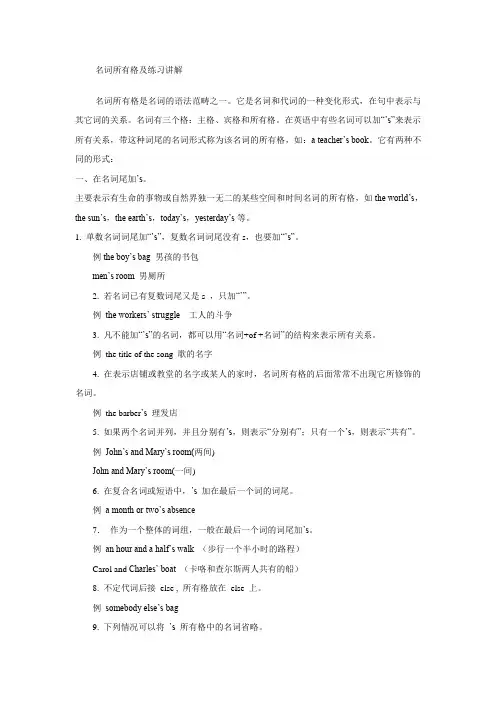
名词所有格及练习讲解名词所有格是名词的语法范畴之一。
它是名词和代词的一种变化形式,在句中表示与其它词的关系。
名词有三个格:主格、宾格和所有格。
在英语中有些名词可以加“’s”来表示所有关系,带这种词尾的名词形式称为该名词的所有格,如:a teacher’s book。
它有两种不同的形式:一、在名词尾加’s。
主要表示有生命的事物或自然界独一无二的某些空间和时间名词的所有格,如the world’s,the sun’s,the earth’s,today’s,yesterday’s等。
1. 单数名词词尾加“’s”,复数名词词尾没有s,也要加“’s”。
例the boy’s bag 男孩的书包men’s room 男厕所2. 若名词已有复数词尾又是s ,只加“’”。
例the workers’ struggle工人的斗争3. 凡不能加“’s”的名词,都可以用“名词+of +名词”的结构来表示所有关系。
例the title of the song 歌的名字4. 在表示店铺或教堂的名字或某人的家时,名词所有格的后面常常不出现它所修饰的名词。
例the barber’s 理发店5. 如果两个名词并列,并且分别有’s,则表示“分别有”;只有一个’s,则表示“共有”。
例John’s and Mary’s room(两间)John and Mary’s room(一间)6. 在复合名词或短语中,’s 加在最后一个词的词尾。
例a month or two’s absence7.作为一个整体的词组,一般在最后一个词的词尾加’s。
例an hour and a half’s walk (步行一个半小时的路程)Carol and Charles’ boat (卡咯和查尔斯两人共有的船)8. 不定代词后接else , 所有格放在else 上。
例somebody else’s bag9. 下列情况可以将’s 所有格中的名词省略。
1)名词所有格所修饰的词, 如果前面已经提到,往往可以省略,以免重复。
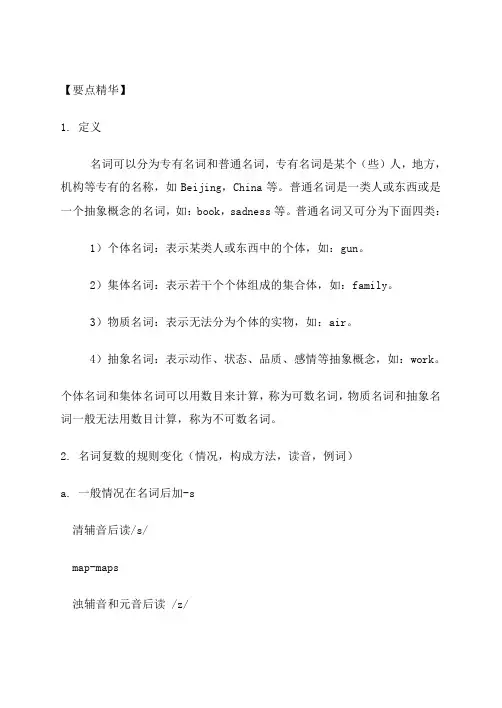
【要点精华】1. 定义名词可以分为专有名词和普通名词,专有名词是某个(些)人,地方,机构等专有的名称,如Beijing,China等。
普通名词是一类人或东西或是一个抽象概念的名词,如:book,sadness等。
普通名词又可分为下面四类:1)个体名词:表示某类人或东西中的个体,如:gun。
2)集体名词:表示若干个个体组成的集合体,如:family。
3)物质名词:表示无法分为个体的实物,如:air。
4)抽象名词:表示动作、状态、品质、感情等抽象概念,如:work。
个体名词和集体名词可以用数目来计算,称为可数名词,物质名词和抽象名词一般无法用数目计算,称为不可数名词。
2. 名词复数的规则变化(情况,构成方法,读音,例词)a. 一般情况在名词后加-s清辅音后读/s/map-maps浊辅音和元音后读 /z/bag-bags /car-carsb. 以s, sh, ch, x等结尾的名词加-es读 /iz/bus-buses/ watch-watches/brush-brushes/box-boxesc. 以ce, se, ze,等结尾加 -s读 /iz/license-licensesd. 以辅音字母+y结尾的名词把变y 为i再加es读 /z/baby---babiese. 以o 结尾的名词,变复数时:1). 加s,如: photo---photos piano---pianosradio---radios zoo---zoos;2). 加es,如:potato--potatoes tomato--tomatoes3). 上述a和b两种方法均可,如zero---zeros / zeroes。
f. 以f或fe 结尾的名词变复数时:1). 加s,如: belief---beliefs roof---roofssafe---safes gulf---gulfs2). 去f, fe 加ves,如:half---halvesknife---knives leaf---leaves wolf---wolveswife---wives life---lives thief---thieves3). 上述a和b两种方法均可,如handkerchief: handkerchiefs / handkerchieves。
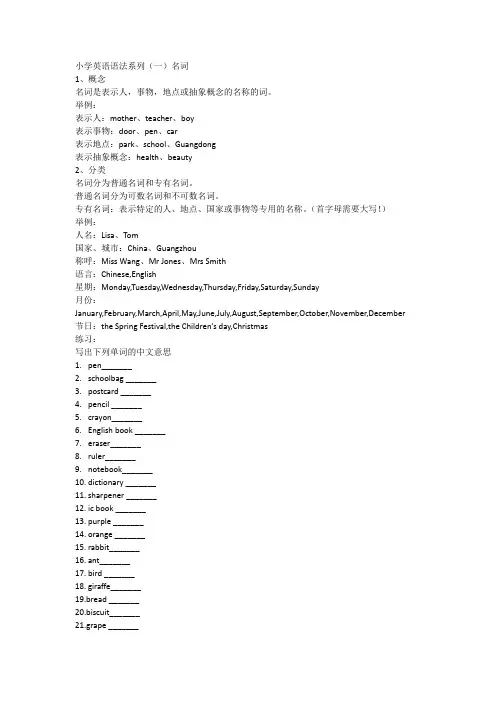
小学英语语法系列(一)名词1、概念名词是表示人,事物,地点或抽象概念的名称的词。
举例:表示人:mother、teacher、boy表示事物:door、pen、car表示地点:park、school、Guangdong表示抽象概念:health、beauty2、分类名词分为普通名词和专有名词。
普通名词分为可数名词和不可数名词。
专有名词:表示特定的人、地点、国家或事物等专用的名称。
(首字母需要大写!)举例:人名:Lisa、Tom国家、城市:China、Guangzhou称呼:Miss Wang、Mr Jones、Mrs Smith语言:Chinese,English星期:Monday,Tuesday,Wednesday,Thursday,Friday,Saturday,Sunday月份:January,February,March,April,May,June,July,August,September,October,November,December 节日:the Spring Festival,the Children’s day,Christmas练习:写出下列单词的中文意思1.pen_______2.schoolbag _______3.postcard _______4.pencil _______5.crayon_______6.English book _______7.eraser_______8.ruler_______9.notebook_______10.dictionary _______11.sharpener _______12.ic book _______13.purple _______14.orange _______15.rabbit_______16.ant_______17.bird _______18.giraffe_______19.bread _______20.biscuit_______21.grape _______22.eggplant_______23.green beans_______24.onion _______25.carrot_______26.train _______27.head_______28.ear_______29.shark_______30.actor_______31.juice_______32.hot dog _______33.tail_______34.kid _______35.socks _______36.shorts_______37.cloth _______38.sunglasses _______39.horse _______40.bear_______41.tiger _______42.egg_______43.tea_______44.meat_______45.neighbour _______46.pen pal_______47.baby _______48.people_______49.driver_______50.farmer_______答案:1、pen钢笔2、schoolbag 书包3、postcard 明信片4、pencil 铅笔5、crayon蜡笔6、English book 英语书7、eraser橡皮8、ruler尺子9、notebook笔记本10、dictionary 词典11、sharpener 卷笔刀12、ic book 漫画13、purple 紫色14、orange 橙色15、rabbit兔16、ant蚂蚁17、bird 鸟18、giraffe长颈鹿19.bread 面包19.biscuit 饼干20.grape 葡萄21.eggplant茄子22.green beans豆角23.onion 洋葱24.carrot胡萝卜25.train 火车26.head 头27.ear耳朵28.shark鲨鱼29.actor男演员30.juice果汁31.hot dog 热狗32.tail尾巴33.kid 小孩34.socks 袜子35.shorts 短裤36.cloth 布37.sunglasses 太阳镜38.horse 马39.bear熊40.tiger 老虎41.egg蛋42.tea茶43.meat肉44.neighbour 邻居45.pen pal笔友46.baby 婴儿47.people 人48.driver司机49.farmer农民。
Contents第一章名词1.名词的数2.名词的格第二章代词1.人称代词2.物主代词第三章冠词与数词1.冠词2.数词第四章一般现在时态第五章现在进行时态第六章句型1.陈述句2.疑问句3.祈使句4.There be 句型与have\ has第七章总结考试第一章名词(Noun)名词的概念在生活中,我们会接触到各种各样的人和事物,用来表示这些人或事物名称的词就是名词。
一、名词的数名词的数指名词的单数和复数形式。
可数名词表示“一个”时用单数,“两个以上”时用复数;不可数名词表示量时,通常用“数词+单位+of+物质名词”的形式,如 a piece of bread (一片面包),变为复数时,只须将单位名词变为复数,如:two pieces of bread(两片面包)。
*名词复数的构成法则1. 一般情况下在词尾加 s. 词尾读音shop --- shops (商店) 在清辅音后读[ s ]bag --- bags (书包) 在浊辅音后读[ z ]window --- windows (窗户) 在元音后读[ z ]2. 以s, x, sh, ch 结尾的单词在词尾加es。
class --- classes (班级) 词尾读音[ iz ]box --- boxes (盒子)match --- matches (比赛)brush --- brushes (刷子)3. 以“辅音字母+y”结尾的词,变y为i 加es.story --- stories (故事) 词尾读音[ iz ]4. 以“元音字母+y”结尾的词,在词尾直接加skey --- keys 词尾读音[ z ]monkey --- monkeys5.以“o”结尾的名词,复数一般在词尾加“s”, 但个别加“es”tomato --- tomatoes (西红柿) 词尾读音[ z ]potato --- potatoes (土豆)zoo --- zoos (动物园)photo --- photos (照片)*(以“o”结尾,复数加“es”)口诀:黑人(Negro)英雄(hero),左手拿着西红柿(tomato),右手拿着破土豆(potato),头顶一个大芒果(mango)。
一、名词名词可以分为可数名词与不可数名词,其中可数名词具有单、复数的形式;而不可数名词没有复数形式。
1. 从单数复数,变形规则如下:1.一般情况下,直接加—s,如:book-books, bag—bags, cat—cats, bed-beds2.以s。
x。
sh. ch结尾,加-es,如:bus-buses, box-boxes,watch-watches 3.以“辅音字母+y”结尾,变y为i,再加—es,如:family—families(家庭), strawberry-strawberries(草莓)4.以“f或fe”结尾,变f或fe为v, 再加—es,如:knife—knives5.不规则名词复数:man-men, woman—women,policeman(男警察)—policemen,policewoman(女警察)—policewomen,mouse-micechild(孩子)—childrenfoot—feet,。
tooth-teethfish-fish, sheep(羊)—sheep people-people,Chinese—Chinese,Japanese—Japanese,当people后加上s时即peoples表示“民族”例如:There are 56 peoples in China。
中国有56个民族.2.以下词为常为不可数名词,他们的复数形式就是他们本身。
Water(水) milk(牛奶) tea(茶) rice(米饭)orange(橙汁)juice(果汁)bread(面包)练习题写出下列各词的复数I _________this ___________that___________watch _______child _______photo ________diary _________day________ foot________ book_______ dress ______________tooth_______ sheep ______box_______ strawberry _____________thief _______yo—yo ______ peach______ sandwich _______________ man______ woman_______ paper_______ juice____________________ water________ milk________ rice__________ tea_______________-注意be 动词遇到名词时的运用:单数名词用is,复数名词全用are。
名词
什么是名词(What is a noun?)
名词是专门用来给一个人,一个地方或者一种事物命名的词。
(A noun is a naming word. It can name a person, place or thing.)
例子:与人相关的boy\girl\doctor\teacher \student\mother\father\ sister\brother
与地点相关的shop\school\Beijing\beach\Chongqing\house
事物的名字\万事万物cat\dog\lion\tiger\book\pencil\pen\chair\ball\ television\shoe
Exercises
1.Find the nouns.
cushion(垫子) pretty(漂亮的) sing(唱歌) bird(鸟)
trousers(裤子) plane(飞机) crispy(脆的) tree(树)
brown(棕色)tall(高的) bed(床) color(颜色)
2.Find the noun in the sentence.
The dog is cute. 这只狗很可爱。
The coat is blue. 这件外套是蓝色的。
Look at the beautiful owl. 看这只美丽的猫头鹰。
3.Fill in nouns to make sentences.
I play the _______.
This is my _____. Her name is Lucy.
I like to eat _____.
My pet is a ____.。
小学英语名词专项练习单数名词和复数名词单数名词表示一个人、动物或物体,而复数名词表示多个人、动物或物体。
练1: 根据单数形式写出下面名词的复数形式。
根据单数形式写出下面名词的复数形式。
1. book: books books2. dog: dogs dogs3. pencil: pencils pencils4. cat: cats cats5. chair: chairs chairs练2: 根据复数形式写出下面名词的单数形式。
根据复数形式写出下面名词的单数形式。
1. apples: apple apple2. cars: car car3. trees: tree tree4. chairs: chair chair5. dogs: dog dog可数名词和不可数名词可数名词可以用数字进行计量,而不可数名词不能直接计量。
练3: 下面的名词是可数名词还是不可数名词?下面的名词是可数名词还是不可数名词?1. apple: 可数名词可数名词2. rice: 不可数名词不可数名词3. book: 可数名词可数名词4. water: 不可数名词不可数名词5. chair: 可数名词可数名词练4: 用合适的名词填空。
用合适的名词填空。
1. I have two ___________. (book)2. She bought some ___________. (apple)3. There is not enough ___________. (water)4. He has many ___________. (friend)5. The car needs new ___________. (tyre)特殊名词有些名词在复数形式上有特殊变化。
练5: 根据单数形式写出下面名词的复数形式。
根据单数形式写出下面名词的复数形式。
1. child: children children2. tooth: teeth teeth3. foot: feet feet4. person: people people5. mouse: mice mice练6: 根据复数形式写出下面名词的单数形式。
语法专项练习---------介绍名词及名词单数变复数名词可以分为专有名词和普通名词,专有名词是人名,地名,机构等专有的名称,如Beijing ,China等。
普通名词中个体名词和集体名词可以用数目来计算,称为可数名词,物质名词和抽象名词一般无法用数目计算,称为不可数名词。
名词变复数,指可数名词变复数1. 一般情况下,直接加-s,如:book-books, bag-bags, cat-cats, bed-beds2. 以s. x. sh. ch结尾,加-es,如:bus-buses, box-boxes, brush-brushes, watch-watches3. 以“f或fe”结尾,去f或fe加-ves,如:knife-knives4. 以“辅音字母+y”结尾,变y为i, 再加-es,如:family-families, strawberry-strawberries5. 以元音字母+y 结尾的名词变复数时,直接加s变复数,如:monkey---monkeys holiday---holidays6. 以o 结尾的名词,变复数时:加s,如:photo---photos zoo---zoos加es如:potatoes tomatoes, Negroes heroes 黑人和超人爱吃土豆番茄7. 常见的不规则变化:man-men, woman-women, policeman-policemen, policewoman-policewomen, mouse-micechild-children, foot-feet, tooth-teeth※注意1) 单复同形如:deer,sheep,fish,Chinese,Japanese2) 集体名词,以单数形式出现,但实为复数。
如:staff people police cattle 等本身就是复数,不能说astaff a people,a police,a cattle3) 表示由两部分构成的东西,如:glasses (眼镜)trousers,clothes。
《小学英语中的名词和代词用法详解》
在小学阶段学习英语是许多学生的第一次接触外语,名词和代词是英语中基础且重要的语法部分。
本文将详细解释小学英语中名词和代词的用法,帮助学生更好地掌握这些知识点。
名词的分类和用法
1.名词的分类
名词可分为专有名词和普通名词。
专有名词是特定的人、地点或事物的名称,如人名、国名等;普通名词则是泛指的名称,如动物、水果等。
2.名词的单复数形式
名词的单数形式和复数形式在英语中常常有规则可循。
一般情况下,名词变成复数形式时,在词尾加上“-s”或“-es”。
代词的种类和用法
1.人称代词
人称代词用来代替特定的人或事物,分为主格和宾格。
例如,“I”(我)是第一人称单数主格代词,“me”(我)是第一人称单数宾格代词。
2.物主代词
物主代词用来表示所有关系,包括形容名词所有权。
例如,“my”
(我的)是第一人称单数形容词性物主代词,“mine”(我的)是第一人
称单数名词性物主代词。
名词和代词的练习
练习题:填空题
Thisis(my)book.
(They)aremyfriends.
Thecatis(its)tail.
通过不断练习名词和代词的用法,可以更好地掌握英语语法知识,提高语言表达能力。
名词和代词是构建英语句子的基础,熟练掌握它们的用法对学习英语至关重要。
通过系统的学习和实践,学生能够在小学阶段建立扎实的语法基础,为日后的英语学习打下坚实的基础。
第二课时语法知识词法(1)
一、名词
表示某一事物,有具体的和抽象的之分。
分为可数名词和不可数名词。
强调:不可数名词都默认为单数,最好不要根据some、any、a lot of等词去作判断,以免受误导。
1、可数名词如何变“复数形式”:
a.一般情况下,直接加-s,如:book-books, bag-bags, cat-cats, bed-beds ;
读音:清辅音后读[s],浊辅音和元音后读[z]。
b.以s. x. sh. ch结尾,加-es,如:bus-buses, box-boxes, brush-brushes,watch-watches;
读音:[iz]。
c.以“辅音字母+y”结尾,变y为i, 再加-es,如:family-families, fly-flies ;
读音:[z]。
d.以“f或fe”结尾,变f或fe为v, 再加-es,如:knife-knives ;读音:[z]。
e.以“o”结尾的词,分两种情况
1)有生命的+es 读音:[z] 如:mango-mangoes tomato-tomatoes hero-heroes
2) 无生命的+s 读音:[z] 如:photo-photos radio-radios
f. 不规则名词复数:man-men, woman-women, policeman-policemen,
policewoman-policewomen, snowman-snowmen, child-children, foot-feet,
tooth-teeth, fish-fish, people-people,
2、不可数名词没有复数。
如果要计算不可数名词所表达的数量,就得在数词和不可数名词之间加上“量词+of”。
例如:a glass of water, a piece of paper, a bottle of juice’
3、名词所有格
在英语中有些名词可以加“s”来表示所有关系,带这种词尾的名词形式称为该名词的所有格。
1)一般人名后直接加“s”,表示某人的。
例如: Lin Tao’s bike林涛的自行车2)如果原词已有复数词尾-s,则仅仅加一个“ s ”,如:teachers’ book老师的书3)如果是复数,但不带词尾-s,则仍然加“s”,
例如:those men’s hats 那些男士的帽子
4)如果表示各自的所有关系时,名词末尾均需加“’s”,
例如:Jim’s and Kate’s glasses 吉姆和凯特各自的眼镜
5)如果表示共同的所有关系时,仅在最后一词的末尾加“’s”,
例如:Jim and Kate’s kite 吉姆和凯特的风筝(两个人共同拥有的)
二、数词
我们学过两类:基数词和序数词。
基数用于表示数量多少,而基数词用于表示次序,常在日期中出现。
区别:基数词前面没有“the”;序数词前一定要有“the”。
1、超过二十以上的两位数需要在个位和十位之间加上“-”。
如:21 twenty-one
2、用基数词来修饰可数名词时,一定别忘了它的复数形式。
如:十八个男孩eighteen boys
3、用基数词修饰不可数名词时,如是复数,变它的量词为复数。
如:两碗米饭two bowls of rice
4、序数词一般加“th”,特殊的有:first, second, third, fifth, eighth, ninth, twelfth 以及二十及二十以外的整十:twentieth, thirtieth, fortieth… “第几十几”:前面整
十不变,后面“几”改为序数词。
如:88 eighty-eighth
三、代词
代词有两种:人称代词和物主代词。
1、人称代词分为:第一、第二、第三人称,且有单复数之分。
2、人称代词的主格在句中做主语,一般用在动词前(疑问句除外);
宾格在句中做宾语,多用于动词、介词后。
3、形容词性物主代词起形容词的作用,后面一定要跟名词,表示该名词是属于谁的。
4、名词性物主代词=形容词性物主代词+名词。
如:This is my bag. = This is mine. That is her ruler. = That is hers.
一般看后面有没有名词,如有,就用形容词性物主代词;如无,就用名词性物主代词。
请牢记下表:
练一练:
一. 用所给名词的正确形式填空。
(1)Here’re five( glass ) of ( juice ) for you.
(2)I can see some ( people ) in the cinema.
(3)How many ( day ) are there in a week?
(4) I have two____________ (knife)
(5)There are ten __________ _________in our school. (woman teacher)
二. 名词所有格练习.
1. __________________________(李明的父母)work in a big hospital.
2. This is __________________________________(我妹妹的语文书).
3. __________________________________(双胞胎的卧室) are very nice.
4. ______________________________(王平和王明的父亲) is a hotel manager.
5. Is this ___________________________________(你的好朋友的钢笔) ?
6. They are ___________________________________(Peter 和Sam的老师).
7. ___________________________(教师节) is on September 10th
三.把下列基数词改成序数词。
one--- two--- three--- nine--- fourteen--- twenty--- thirty-five--- eighty-one---
1、March is (3)month of the year.
2. (1) Day of the week is Sundaly.
3.There are students in our class, twenty boys and twenty girls.
4.We have________(12)months of the year.
四、1、按要求写出相应人称代词。
I(宾格)_______ she(物主代词)_______ we(物主代词)_______ he(复数)_______ us(单数)_______ hers(主格)_______ they(宾格)_______
2、用所给词的适当形式填空。
1)That is not _______ kite. That kite is very small, but ______kite is very big. ( I ) 2)Kim is an English girl._________ eyes are blue.(she)
3)Is this _________ watch? ( you )
4)_________ is my brother. ________ name is Jack. . ( he )
5)Mr Yang is_______(we) teacher.________(him)is from Beijing.
_______(his) teaches______(our) English.。